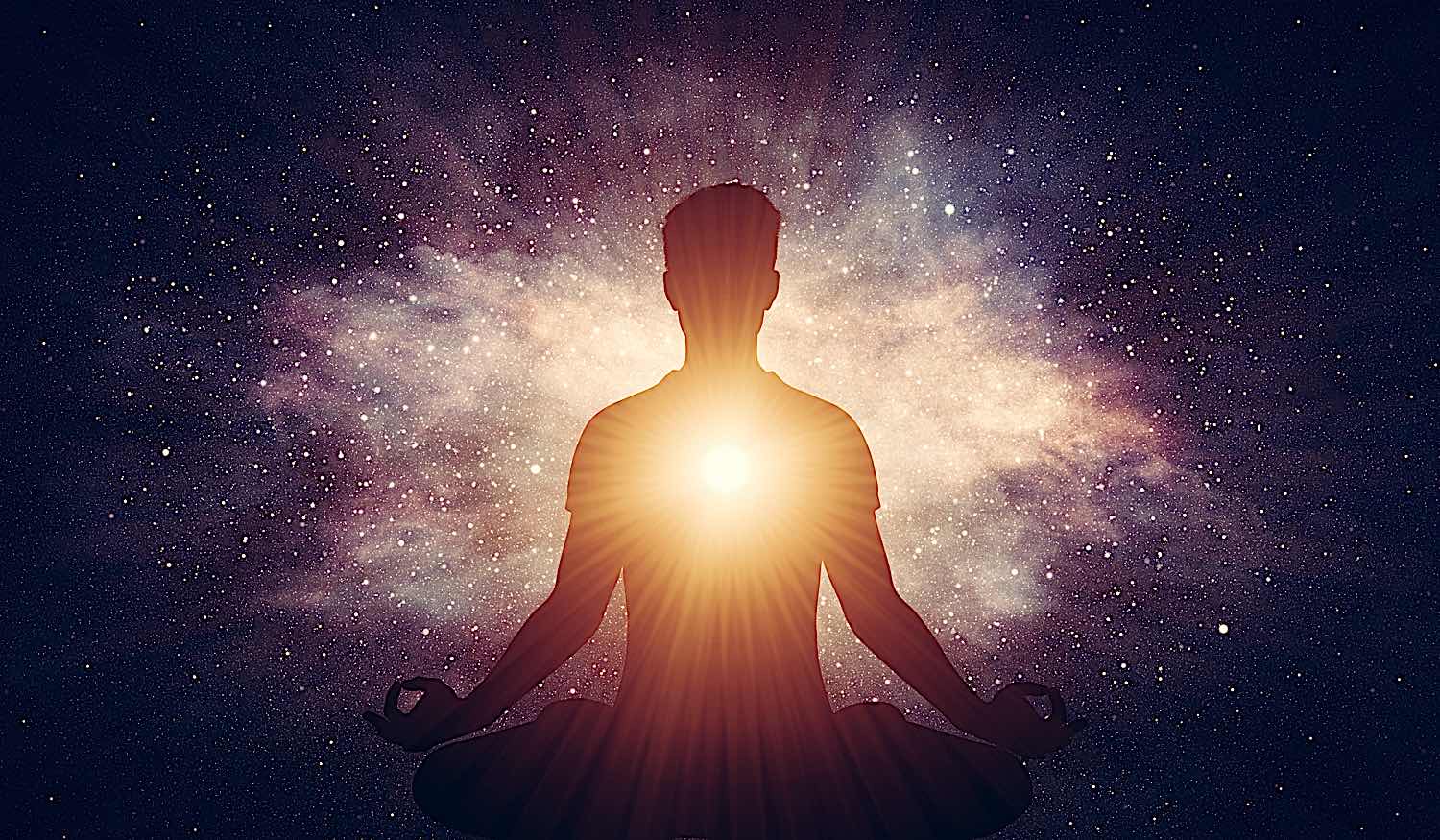10 ways Science aligns with Buddhist concepts: Science and Buddhism concur on method, openess, cosmology, temporal concepts and more
What ten ways do current science and modern Buddhism actually appear in agreement? What ten teachings of Buddha align well with well-accepted modern science? We look at these questions, and much more, in this special feature of “The Scientific...

What ten ways do current science and modern Buddhism actually appear in agreement? What ten teachings of Buddha align well with well-accepted modern science? We look at these questions, and much more, in this special feature of “The Scientific Buddhist”
The Buddhist Method of Analysis could be said to be “experiential” while the Scientific Method of Analysis is usually controlleed “experiment.” Yet, surprisingly, on ten key points, both agree on certain findings.
 A meditating astronaut. Meditation methods — today explored by NASA — may well be life-saving in deep space travel.
A meditating astronaut. Meditation methods — today explored by NASA — may well be life-saving in deep space travel.In this feature we’ll explore ten ways that science supports the teachings of Buddhism. From the similarities between the two systems of belief to their shared focus on truth and understanding, it’s clear that these two paths have a great deal in common.
Whether you’re a practicing Buddhist or simply interested in the correlation between these two disciplines, read on to learn more!
Science and spirituality do not always see “reality” in the same way — perception being relative. There have been many times when the two have been at odds with each other to the point of antagonism.
Buddhism has always been the “open path” — Buddha specifically taught us with discerning wisdom and admonished us to not accept anything on faith.
For a sutra teaching on this concept “Buddha teaching by analysis”, see the Vibhanga Sutta translated here>> For a feature discussing how Buddha taught a concept of the multiverse and time 2500 years ahead of modern science, see>> For a feature on the limitless multiverse, and Buddhist is-ness or thus-ness, see>>>> Science and Buddhism are not incompatible. In fact, they have more similarities than contradictions.
Science and Buddhism are not incompatible. In fact, they have more similarities than contradictions.
1 – Meditation — Science and Buddhism concur
First on the list is meditation. Perhaps the clearest way in which Buddhism and science align is in their shared focus on the mind-body connection. Meditation is a practice revolving around the control and focus of the mind, and it has been shown to have a plethora of benefits for both our mental and physical health.
It is unclear when exactly meditation began, but it is thought to date back at least 5,000 years. The earliest known references to the practice come from the Hindu Vedas, also mentioned in ancient Buddhist texts. In both cases, meditation was used as a way to achieve higher states of consciousness and connection with the divine.
 Matthieu Ricard is still smiling after a grueling, claustrophobic meditation session in an MRI. He is a monk participant in an extensive study on compassion’s effect on happiness and health.
Matthieu Ricard is still smiling after a grueling, claustrophobic meditation session in an MRI. He is a monk participant in an extensive study on compassion’s effect on happiness and health.
There are many types of meditation, including but not limited to:
Mindfulness meditation
This form of meditation is all about being present in the moment and observing your thoughts without judgment. You can learn to control your thoughts and emotions more effectively by training your mind to focus on the present.
Mantra meditation
This type of meditation involves repeating a certain word or phrase (known as a mantra) repeatedly. The aim is to clear your mind of all other thoughts so that you can focus solely on the mantra.
Visualization meditation
This practice involves focusing on a specific image and holding it in your mind for the duration of the meditation. Visualization can be used to achieve specific goals, such as improving your health or manifesting something.
Focused breathing meditation
As the name suggests, this type of meditation involves focusing on your breath. The goal is to slow down your breathing and achieve a state of deep relaxation.
Loving-kindness meditation
This practice involves sending positive thoughts and energy to yourself and others. The aim is to cultivate feelings of compassion, love, and understanding.
There are countless other types of meditation, but these are some of the most popular. And while they may all seem different at first glance, they all share one common goal: to improve your mental and physical health.
Buddhism: core practices
From Chan Buddhism to Zen, meditation is integral to the Buddhist path. In fact, Buddha himself is said to have achieved enlightenment through meditation. He famously said: “He who is mentally concentrated sees things according to reality.” [1]
Meditation is seen as a way to quiet the monkey mind and achieve a state of inner peace. Meditation frees us from the prison of our own thoughts and allows us to see the world more clearly. It is believed that by calming the mind, we can better understand our true nature and find freedom from suffering.
Delusions disappear, and we are able to see things as they really are. We become more mindful and present, and our compassion for others grows. In short, meditation helps us to become the best version of ourselves.
 The goal of achieving Theta waves during meditation is difficult but worthwhile. Research shows there are significant health and cognitive benefits. (Simulation in this image only, not actual theta.)
The goal of achieving Theta waves during meditation is difficult but worthwhile. Research shows there are significant health and cognitive benefits. (Simulation in this image only, not actual theta.)
Science: benefits of meditation
In recent years, there has been a growing body of scientific research on the benefits of meditation. Meditation has been shown to improve our mental and physical health in a variety of ways. Although these studies were performed on small samples and more research is needed, the findings are promising. [2]
Some of the benefits of meditation include:
Reduced stress and anxiety
Meditation can help to reduce stress and anxiety by calming the mind and body. In one study, it was found that mindfulness meditation can change the structure of the brain to make us less anxious. The amygdala, which is the part of the brain that controls fear and anxiety, shrinks when we meditate regularly.
Improved concentration and focus
Meditation can also help to improve our attention and focus. Habituation is a process by which we become less sensitive to stimuli that are constantly present. This is why we don’t hear the background noise in a room after a while. Meditation works in a similar way; the more we meditate, the better our concentration becomes.
Furthermore, these benefits appear to be present up to five years after consistent meditation training. This suggests that the changes meditation produces in the brain are long-lasting.
Increased compassion
Loving-kindness meditation is especially effective at increasing empathy. In this practice, we send positive thoughts and energy to ourselves and others. Research has shown that people who regularly meditate in this way can rearrange their default mode network – the part of the brain responsible for our sense of self in the world – to become more compassionate.
There are many other benefits of meditation, such as increased self-awareness, decreased rumination, and improved sleep quality. Meditation is a simple practice that can profoundly affect our mental and physical health.
 Genuine cognitive and health — and Dharma — benefits are associated with attaining Theta brainwaves.For a feature on Theta meditation benefits, see>>
Genuine cognitive and health — and Dharma — benefits are associated with attaining Theta brainwaves.For a feature on Theta meditation benefits, see>>
2 — On inquiry and methodology — Buddhism and science agree
Another area where Buddhism and science intersect is in the area of logic. The scientific method is based on logical reasoning, and Buddhist philosophy relies heavily on logic as well. In fact, one of the main goals of Buddhist practice is to develop our own capacity for logical reasoning so that we can better understand the world around us.
Many religions revolve around the concept of faith. Believers need not question their faith, as it is seen as a source of comfort and understanding. Gods, heavens, and other supernatural beings are taken on faith. In Buddhism, however, faith is not seen as a source of truth. Buddha taught the doctrines of logical analysis and exploration.
Buddha taught with logic and analysis Magga-vibhanga Sutta>> The science of your center — the Vagus nerve>>Buddhist method: experiential
Buddhism relies on our own personal experience and observation to determine what is true. That’s why the Buddha always encouraged his followers to question everything, even his highly-praised teachings. He did not want people to accept his words blindly but rather to test them for themselves and see if they were true.
The following quote from Sutra sums up this idea nicely:
“Do not believe in anything simply because you have heard it. Do not believe in anything simply because it is spoken and rumored by many. Do not believe in anything simply because it is found written in your religious books. Do not believe in anything merely on the authority of your teachers and elders. Do not believe in traditions because they have been handed down for many generations.
But after observation and analysis, when you find that anything agrees with reason and is conducive to the good and benefit of one and all, then accept it and live up to it.” [3]
Scientific method — experimental
The scientific method is based on the same principle of seeking truth through our own observation and experience. Scientists do not take anything on faith; rather, they constantly test their hypotheses to see if they hold up to scrutiny.
The scientific method is a way of learning that emphasizes empiricism, or the observation of events in the natural world. The first step in the scientific method is to make an observation. Scientists then form a hypothesis, or a guess, about what they think is happening. They test their hypothesis through experimentation, and if their results support it, they form a theory. Theories are constantly being tested and revised as new information comes to light.[4]
The scientific method is an ongoing process of learning about the world around us. It is a way of constantly testing our hypotheses and expanding our understanding of the natural world.

3. Cosmos — according to Buddhism, and science
The most baffling similarity between Buddhism and science is the concept of cosmic Buddhism. Considering the Buddha lived over 2,500 years ago, it is remarkable how closely his teachings align with modern cosmology. From the Big Bang to the multiverse, the Buddha’s teachings echo the discoveries of contemporary science.
Whether modern science-based their theories on his teachings or simply arrived at the same conclusions independently is up for debate. What is certain, however, is that the Buddha’s understanding of the cosmos was far ahead of his time.
We covered this topic extensively here, in our feature on the Multiverse>>Here are some examples of how the Buddha’s teachings on cosmology align with modern science:
Cosmos In Buddhism
The Buddha taught that everything is connected. He said that everything arises from causes and conditions and that nothing exists independently. This is a fundamental principle of physics known as causation.
The Buddha also taught that everything is in a state of flux. He said that everything is impermanent and constantly changing. It is known as the law of impermanence and is one of the most fundamental laws of physics.
As for the multiverse, many Buddhist scriptures mention multiple universes. In the Pali Canon, for example, the Buddha says there are an infinite number of worlds. The Mahayana tradition also teaches that there are an endless number of universes, each with its own Buddha. [5]
Cosmos in science
In modern cosmology, the Big Bang is the theory that explains the origin of the universe. It states that the universe began as a singularity or a point of infinite density and temperature. The universe expanded and cooled from this singularity, creating the stars, galaxies, and planets we see today.
The law of causation states that everything has a cause. In other words, nothing can happen without reason. It is a fundamental principle of physics, allowing scientists to make predictions about the future.
One theory for the end of our universe is the Big Crunch. Big Crunch is theoretically the opposite of the Big Bang, and states that the universe will eventually stop expanding and begin to contract. As it contracts, it will become increasingly dense and hot until it finally collapses in on itself, creating a new singularity. [6]
This theory aligns with the cyclical concept of rebirth in Buddhism. According to Buddhist teachings, everything is in a state of flux. Nothing lasts forever, and everything is constantly changing. This includes the universe itself, which is reborn again and again in an endless cycle.
4. The causes of suffering
Next, we’ll look at how the Buddha’s teachings on the causes of suffering align with modern science. It’s no secret that, as human beings, we suffer. We experience pain, loss, and heartache. We get sick, and we age. Suffering is an inescapable part of life. Many of us go through life searching for a way to end our suffering.
Some try to numb the pain in their own way, while others look for something to blame. But the Buddha taught that external factors do not cause suffering.
“Suffering” cause: Buddhism
Instead, suffering is caused by our own thoughts and actions. The Buddha said that we suffer because of our attachment to impermanent things. We suffer because we want things to be a certain way, and when they’re not, we get upset. We want material goods, but they eventually break or wear out. We want our bodies to be healthy, but nobody is immortal.
The Buddha also taught that suffering is caused by our ignorance. We suffer because we don’t understand the true nature of reality. We think things are permanent when they’re not, and we believe things are separate when they’re not. This misunderstanding leads to a lot of unnecessary suffering.
Our vices, such as greed, hatred, and delusion, all stem from ignorance. [7]
“Suffering” cause: Cognitive Sciences
Cognitive science, the study of the mind, has shown that our thoughts and actions indeed cause our suffering. According to cognitive science, we create our reality with our thoughts.
A human brain is a prediction machine. It takes in information from the world around us and uses it to make predictions about what will happen next. These predictions help us to make sense of the world and navigate our way through it.
However, our brain is not always accurate. Sometimes it makes false assumptions, which can lead to suffering. Anxiety, for example, is caused by our brain making wrong predictions about future events.
We also know that depression can be caused by a disconnect between our current reality and our expectations. We might want to be happy, but if our reality doesn’t match up with our expectations, we can end up feeling disappointed and down. [8]
5. Physics
Physics is the study of the fundamental principles governing the natural world. These principles include the laws of motion, energy, and thermodynamics. Physics is a branch of science that has been around for thousands of years, and it continues to be one of the most popular fields of study today.
Physics in Buddhism
Buddhism also teaches about some of the fundamental principles governing the natural world. These principles include the law of karma and the law of dependent origination. The law of karma is the law of cause and effect. It states that our thoughts and actions have consequences and that we will experience the results of our own actions.
Impressively, early Buddhists also had a rudimentary understanding of the atom. Indian Buddhist philosophers taught that everything in the universe is made up of atoms, described as point-sized particles that are durationless. That means they have no extension in space, and they last for zero time. [9]
These atoms are made of energy, and they’re in constant motion. They come together to form larger objects but can also be dissolved into their constituent parts.
Science
The modern understanding of the atom is very similar to the Buddhist version of the atom. They are the smallest particle of an element that has the chemical properties of that element. Atoms are made of protons, neutrons, and electrons. These protons and neutrons make up the atom’s nucleus, and the electrons orbit around the nucleus.
Atoms are in constant motion. They vibrate, rotate, and move around. They also interact with other particles to form molecules.
Like Buddhists, physicists also believe that atoms are made of energy. In fact, the word “atom” comes from the Greek word for indivisible because it was once thought that atoms were the smallest and most indivisible particles in the universe. Of course, we now know that atoms are somewhat divisible and that the resulting reaction would release a tremendous amount of energy. [10]
Buddhism and physics both teach that everything in the universe is made of energy. This is a fundamental principle governing the natural world.
6. Cognition and Mindfulness
Not to be confused with meditation, mindfulness is the practice of being present in the moment. It’s about paying attention to your thoughts, feelings, and sensations without judgment. We can be mindful of the sensations in our body, or we can be aware of the sounds around us. We can be cognizant of our thoughts, or we can be mindful of our breathing.
Although mindful meditation is a type of mindfulness, mindfulness doesn’t have to be meditation. It can be any activity that helps you to focus your attention on the present moment. For example, you can be mindful of your thoughts while you’re walking, or you can be mindful of your breathing while you’re eating.
Simply put, meditation has specific goals and techniques — while mindfulness is being aware of something as an observational “process.”
Mindfulness In Buddhism
The state of bare awareness is a core element of mindfulness and central to Buddhist meditation. In fact, some people say that the two are synonymous. The aim of Buddhist meditation is to achieve a state of bare awareness, where we are simply observing our thoughts without judgment.
When we are in a state of bare awareness, we are not trying to control our thoughts. We are not trying to get rid of our thoughts. We are simply observing them without judgment. In the Metta Sutta, the Buddha himself said:
“Just as a mother would protect with her life her own son, her only son, so one should cultivate an unbounded mind towards all beings and loving-kindness towards all the world. One should cultivate an unbounded mind, above and below and across, without obstruction, without enmity, and without rivalry. Standing, or going, or seated, or lying down, as long as one is free from drowsiness, one should practice this mindfulness. This, they say, is the holy state here.” [11]
Benefits of mindfulness in science
Mindfulness has been shown to have a number of benefits for our mental and physical health. For example, it can help to reduce stress, anxiety, and depression. It can also help to improve our sleep quality, and it can boost our immune system.
In fact, there is a growing body of scientific evidence to support the health benefits of mindfulness. A recent study found that mindfulness meditation can change the structure of our brains. The study found that mindfulness meditation can increase the gray matter in our hippocampus, which is the part of the brain responsible for learning and memory. [12]
Gray matter usually decreases as we age, so the findings of this study suggest that mindfulness meditation can actually slow down the aging process of our brain.
Like meditation, mindfulness has also been shown to help us to control our emotions. A study found that mindfulness can help to reduce our reactivity to negative emotions, and it can also help us to recover from them more quickly.
7. Visualization — seeing our thoughts?
Part of mindfulness is being aware of our thoughts. But what if we could see our thoughts? That’s where visualization comes in. Visualization is a type of meditation where we focus on creating mental images. We can visualize anything we want, from a calm ocean to a beautiful garden. The aim of visualization is to use our imagination to create positive mental images that can help us to relax and find peace.
It is a practice used by religious people and non-religious people alike. Note that visualization is different from daydreaming. Daydreaming is when our mind wanders, and we are not in control of our thoughts. Visualization is when we intentionally focus on creating positive mental images — either recalled (memories) or constructed (imagined proactively.)
There are many different ways to visualize. You can use guided visualization, where someone else leads you through the process, or you can do it on your own. You can also use visualization to imagine yourself in different situations, or you can use it to create a mental image of something you want to manifest in your life.
In Buddhism: as method
A visualization is a powerful tool that can be used for many different purposes. In Buddhism, visualization is often used to create positive mental images of the Buddha or of enlightened beings. These images can help us to feel closer to the Buddha and to receive his teachings. They can also inspire us to live our lives in a more compassionate and virtuous way.
In some cases, practitioners are encouraged to visualize themselves as the Buddha. This can help us see ourselves in a more positive light and realize our potential for enlightenment. It can also remind us of the importance of compassion and kindness. It is also a method for helping us understand the illusory nature of reality — and the role our sensory inputs play in creating these perceptions [13]
As a part of Tantric Buddhism, visualization can also be used to transform our negative emotions into positive ones. For example, we can visualize anger as a ball of fire that burns up our negativity. Or we can visualize love as a warm light that fills us with compassion and understanding.
Visualization can help us relax, find peace, and connect with our Buddha nature.
In science: imagery rehearsal therapy
The science behind visualization is called “mental imagery” or “imagery rehearsal therapy.” It is a type of cognitive-behavioral therapy that has been shown to be effective in treating conditions like anxiety, depression, and PTSD.
Mental imagery works by helping us to change the way we think about our experiences. For example, if we are anxious about an upcoming test, we can use mental imagery to visualize ourselves passing the test with flying colors. This can help to reduce our anxiety and to increase our confidence.
Mental imagery is often used by professional athletes to improve their performance. They will visualize themselves winning the game or hitting the perfect shot. That can help to increase their motivation and confidence, and it can also help them to perform better when they are actually playing. [14]
Likewise, singers or performers can use mental imagery to visualize themselves giving a great performance. It can help to reduce stage fright and to increase their confidence. But you don’t have to be a professional athlete or performer to benefit from visualization. Anyone can use mental imagery to improve their health, their mood, and their overall well-being.
8. Nirvana and “pure consciousness”
Nirvana is the goal of the Buddhist path. It is a state of perfect peace and freedom from suffering. Nirvana is not a place but rather a state of being. It can be attained in this lifetime through the practice of meditation and other spiritual disciplines. It is not really like the concept of “heaven” or heavenly realms. It transcends those concepts.
Nirvana is often described as a state of perfect blissful wisdom. In this state, there is no more suffering or rebirth. This does not mean that Nirvana is a state of nothingness. Rather, it is a state of complete and perfect peace.
Nothingness is a poor translation of the Buddhist term Shunyata, or Emptiness. This is a difficult topic, we’ve previously covered in this feature and many others>>Nirvana is also sometimes compared to the experience of death. Just as death is the end of our physical life, Nirvana is the end of our spiritual life.
In Buddhism
It’s important to understand that Nirvana is possible to attain in this lifetime. In Mahayana Buddhism, the goal is to train towards Enlightenment but as the “driver of the big bus” — bringing all sentient beings with us. It’s not enough to simply find release for ourselves.
Nirvana is not some far-off destination that we can only hope to reach in the next life — even though the metaphor is often “the other shore.” Nirvana is a state of being that we can achieve through our own efforts.
Although most people who try to attain it are monks or nuns who have dedicated their lives to the practice, it is possible for laypeople to reach Nirvana as well. In fact, anyone can achieve Nirvana if they are willing to put in the effort. By accumulating good karma and following the Noble Eightfold Path, we can all eventually reach Nirvana.
Nirvana is the culmination of the Buddhist path — for ourselves and, in the case of Mahayana, all sentient beings. It is the goal that we are striving for. But it is also important to remember the path itself is meaningful. The journey is just as important as the destination. There are realizations along the way which sustain us and help us grow. [15]
In science — “pure consciousness”?
There is no scientific equivalent to Nirvana, but some scientists believe that it might be possible to achieve a state of “pure consciousness” or even “consciousness without content.” Pure consciousness is a hypothetical state of being detached from what we would currently class as a physical body — the stuff of science fiction, perhaps, but it’s still a notion in science.
The alternate concept is “consciousness without content.” This is a state in which the mind is aware, but no thoughts or emotions are present.
Some people believe this state is similar to what happens when we die. When our physical body dies, our consciousness is no longer bound to it. This could potentially allow us to experience a state of pure consciousness.
There is also some scientific evidence that certain psychedelic drugs can help us to achieve a state of pure consciousness. Also called “Ego Death,” this state is characterized by a loss of self-awareness and a sense of oneness with the cosmos. Countless people have reported having mystical experiences while under the influence of psychedelics like magic mushrooms (psilocybin,) LSD, and DMT. [16]
9. Cause and effect
Karma is the law of cause and effect. It is the belief that our actions have consequences and will come back to us in this life or the next life. The law of karma is often expressed as “what goes around, comes around.” This means that if we do good deeds, we will receive good karma. If we do bad deeds, we will receive bad karma.
It is often misunderstood to mean that if we suffer in this life, it is because we deserve it. This is not the case. Karma is not a form of punishment or reward. It is simply a law of cause and effect. Our actions have consequences, and those consequences will come back to us. As such, the law of karma is often compared to the law of gravity.
Karmic law in Buddhism is slightly different from science’s take, but the idea is very similar. In science, the cause explains the effect. The law of karma is the same.
10. The theory of evolution and Buddhist dependent arising
Last but not least is the theory of evolution. This is the belief that all life on Earth developed over time, through the process of natural selection, these ancestors have evolved into the myriad of different species that we see today. Charles Darwin’s theory of evolution is one of the most well-known and widely accepted scientific theories.
The theory of evolution is also found in Buddhism. In the Agganna Sutta, a Buddhist scripture, the Buddha describes how human beings have evolved over time, going through the never-ending cycle of birth, death, and rebirth. There is also no fundamental difference between humans and animals in Buddhism. All beings are equal and have the same right to live. [17]
Of course, Darwin’s microbiology takes the idea of evolution to a whole different level. Thanks to modern technology, he understood the concept of cells and DNA, which allowed him to develop the idea of natural selection.
Concluding thoughts: the Dalai Lama
“If scientific analysis were conclusively to demonstrate certain claims in Buddhism to be false, then we must accept the findings of science and abandon those claims.” – Dalai Lama XIV.
This quote sums up the relationship between Buddhism and science perfectly. One should never blindly accept anything, regardless of whether it is religious or scientific. We must always question and examine everything for ourselves. This way of thinking allowed Dharmic traditions like Buddhism to grow and develop over time. It is also what allows science to make novel discoveries.
Buddhism and science are not at odds with each other. In fact, they are complementary. Science can help us to understand the nature of reality, while Buddhism can help us to understand the nature of our minds. By combining both approaches, we can gain a more holistic understanding of ourselves and the world around us.
Sources
[1] https://www.huffpost.com/entry/why-do-buddhists-meditate_1_b_13735868#:~:text=As%20the%20Buddha%20once%20said,cloud%20our%20mind%20and%20judgment.
[2] https://www.mindful.org/10-things-we-know-about-the-science-of-meditation/#:~:text=According%20to%20neuroscience%20research%2C%20mindfulness,stress%20when%20we%20experience%20it.
[3] https://www.faena.com/aleph/buddha-socrates-and-the-importance-of-thinking-for-ourselves
[4] https://www.techtarget.com/whatis/definition/scientific-method#:~:text=The%20scientific%20method%20is%20the,and%20finally%20analyzing%20the%20results.
[5] https://www.forbes.com/sites/fernandezelizabeth/2020/01/12/the-multiverse-and-eastern-philosophy/?sh=1efa30827209
[6] https://en.wikipedia.org/wiki/Big_Crunch
[7] https://www.pbs.org/edens/thailand/buddhism.htm#:~:text=In%20Buddhism%2C%20desire%20and%20ignorance,them%20can%20only%20bring%20suffering.
[8] https://www.psychologytoday.com/ca/blog/your-neurochemical-self/201608/stop-anxiety-adjusting-expectations
[9] https://en.wikipedia.org/wiki/Buddhist_atomism#:~:text=Indian%20Buddhist%20philosophers%2C%20including%20Dharmakirti,existence%20of%20substantial%20matter%20altogether.
[10] https://en.wikipedia.org/wiki/Atom
[11]https://www.azquotes.com/quote/667706
[12]https://www.ncbi.nlm.nih.gov/pmc/articles/PMC3004979/
[13] https://www.oxfordbibliographies.com/view/document/obo-9780195393521/obo-9780195393521-0175.xml#:~:text=Tantric%20Buddhism%20contains%20often%20elaborate,of%20the%20body%20and%20mind.
[14] https://www.teamusa.org/USA-Artistic-Swimming/Resources/Coaches/Coaching-Materials/-/media/6F11CF2B1E18473E86795C5D46E16BA6.ashx
[15] https://en.wikipedia.org/wiki/Nirvana_(Buddhism)
[16] https://en.wikipedia.org/wiki/Ego_death
[17] https://en.wikipedia.org/wiki/Agga%C3%B1%C3%B1a_Sutta

 JimMin
JimMin 
































